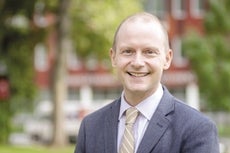
Clark’s plan to demolish a Main Street block has raised concerns about the long-standing relationship between the school and the diverse, low-income neighborhood where it is located
 Photo | MATT WRIGHT
Joseph Corazzini, Clark's vice president for government and community affairs, said the university is intentionally working to ensure the relationship with Main South remains strong.
Photo | MATT WRIGHT
Joseph Corazzini, Clark's vice president for government and community affairs, said the university is intentionally working to ensure the relationship with Main South remains strong.
Growing up as a student at the University Park Campus School in Worcester’s Main South neighborhood, Nate Lopez viewed Clark University as exceptionally open to his community, as he took gym classes at Clark’s Dolan Field and attended his graduation ceremony inside Atwood Hall.
Starting as a first-year student at Clark still felt like a culture shock, Lopez said, as he found the university’s demographics – about 26% people of color for non-international undergraduates, per the school’s website – didn’t mirror those of Main South, which is roughly 67% non-white, according to the nonprofit Main South Community Development Corp.

“Clark University does market themselves as an institution that is really open for the community,” said Lopez, who graduated in 2020 and now works as an educator in Worcester. “As young people, we eat that up basically.”
A contradiction with how Clark advertises its relationship with Main South is how Lopez described the university’s newest development plan, which calls on the demolition of three historic buildings along Main Street containing small businesses in 2024, in order to construct a seven-story building to house more than 500 students by 2026. Clark’s current student housing is at 103% capacity.
The demolition, announced publicly in a Worcester Historical Commission meeting on Aug. 10, would impact eight local businesses currently operating along 926-934 Main St., mostly owner-operator small businesses run by people of color.
“It’s clearly a shift in their branding,” said Steve Teasdale, executive director of the Main South CDC, which, since its founding in 1986, has partnered closely with Clark to revitalize the neighborhood.
Shift after three decades
On its website, Clark says it is “a proud member of the Main South neighborhood,” which has “worked to help this storied Worcester neighborhood emerge from its industrial past to shape a vital present and to plan for an exciting future.”
For Tori MacKay, a rising junior at Clark, this mission was one of the reasons she applied there.

“This area of Worcester being closely connected with Clark is definitely something that drew me in,” MacKay said.
While MacKay said she’s witnessed a significant need for more student housing on campus, she noted the overwhelming majority of students she’s heard from are against the new development proposal.
Comments on an Instagram post by @clarkumemes sharing Worcester Business Journal’s scoop on the project were largely negative, with one user saying, “As an incoming freshman who’s looking to study history, this does not bode well.” A student-made petition against the demolition plans has garnered more than 700 signatures on Change.org.
“I do feel like [the project] is negatively affecting the relationship [with Main South] because it’s like Clark is trying to almost take over,” MacKay said. “It’s not so much being destroyed, but like it’s wearing out.”
Starting in the 1980s, Clark has worked with the CDC to improve Main South, which has the highest poverty level and lowest household income of the 15 Worcester neighborhoods, according to a Worcester Regional Research Bureau analysis. The university has provided lines of credit for the CDC to redevelop dilapidated properties into hundreds of housing units, offeried small business loans and technical assistance, and jointly founded the UPCS where Lopez attended.
Although several of those programs remain ongoing, Teasdale described the CDC’s current relationship with Clark as cautious. The CDC heard about the demolition plans a while ago but was surprised to learn the building’s size days before the plans were publicly shared.
“There has been a change in the dynamics of the relationship with Clark,” Teasdale said. “That really is a direct result of the development agenda that Clark is pursuing at the moment in his area.”
Joseph Corazzini, Clark’s vice president for government and community affairs, said the relationship with the neighborhood remains strong.
Corazzini has seen “intentionality, particularly by the president, to ensure that the project is done right and that it’s done in partnership with the community,” he said.
Since January 2022, Corazzini has been communicating with the businesses on the block and arranging transition plans with financial compensation for their relocations, he said, without specifying how much those compensation packages would be.
There are plans to begin meeting with student leaders and host a town hall in the fall.
David Chearo, Clark’s chief of staff and vice president for planning, said he’s not sure how much the relationship has changed compared with 10 or 20 years ago because he arrived in 2020 at the height of the COVID-19 pandemic. Overlapping for a year, Chearo worked closely with Jack Foley, Corazzini’s predecessor and an architect of the Clark-CDC partnership.

Foley retired in 2021 after 45 years with the university; he could not be reached for this story.
Chearo and Corazzini aren’t the only newcomers to Clark’s administration; all six of the university’s vice presidents arrived with or after President David Fithian took office in July 2020.
Over Fithian’s three-year tenure, Clark has broken ground on a new media arts center along Woodland and Hawthorne streets around the corner from the site of the proposed building. The school purchased a seven-acre vacant lot on Park Avenue, which Chearo said is likely to include an athletic center, adding the university really hasn’t tested plans for housing there.
“We’re focused on continuity in the way in which we impact the community,” Chearo said. “We’re trying to stay within our existing footprint.”

Preparing for a new era
Since the 1980s, Clark has owned the three buildings set for demolition, according to the Worcester District Registry of Deeds. The university rented the ground floors to small business owners, while using upper floors for its student housing needs.
While some of the businesses operating there are new, like the Salvadoran bakery Belén Casa de Pan opened in March, others have rented for decades.
Business owner Wilfredo Santana Jr. said he was a little hesitant when he first heard about Clark’s plans to demolish the building, which has housed his Santana Company Barbershop for the past decade and his mother’s beauty salon, Smart Cuts Plus, for almost 40 years.
“Everybody was a little bit fearful because of the unknown,” he said.
Over the past two decades, the university has kept rents consistent at around $700 a month on average, said Corazzini, but that is likely to change with the new building.
“Naturally, [rents] are going to have to go up,” said Corazzini, though he’s not sure by how much. “The intention is to try to keep them affordable and to try to scale any potential increases over a period of time that allows [the businesses] to transition back successfully.”
Santana, who said he’s come around to the idea since communicating more with Clark, predicted he would come back to the new building. The project is estimated to take about two years to construct and would include 10,000 square feet of ground-floor retail, a 1,000-square-foot increase from the existing commercial space, according to Clark’s presentation to the historical commission meeting.
All eight businesses have expressed to Clark an intention to return to the block, Corazzini said, but Teasdale isn’t as optimistic, arguing if businesses invest in relocating during construction, they won’t want to pack up and move again once the development is complete.
“Once those businesses are gone, they’re not coming back.” Teasdale said.












0 Comments